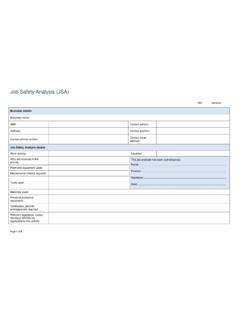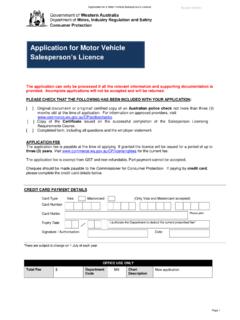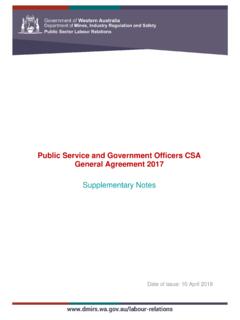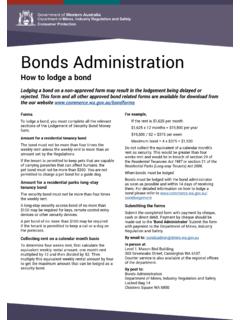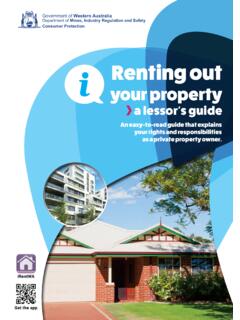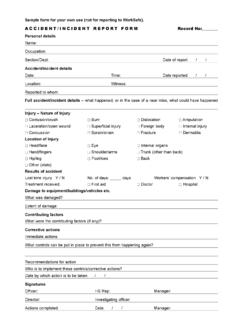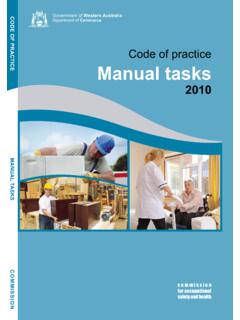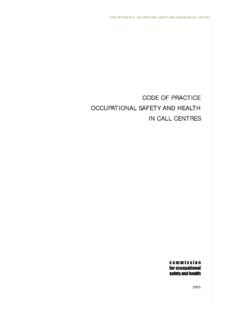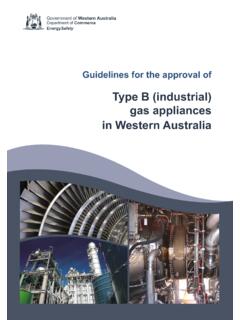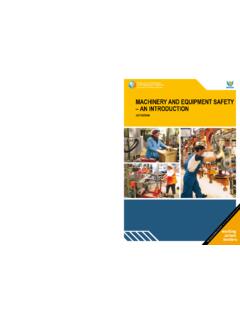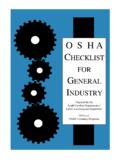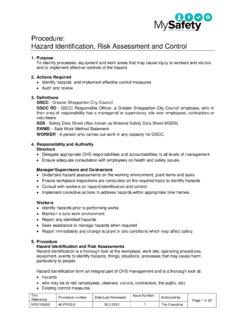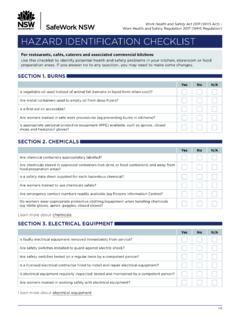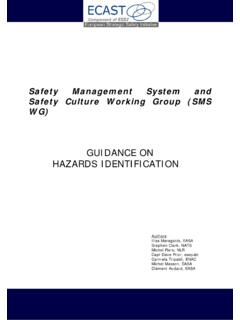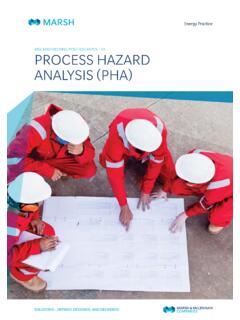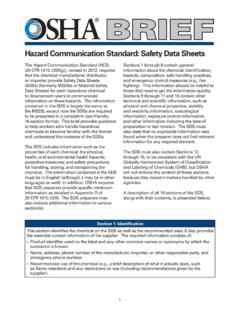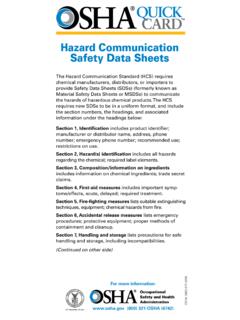Transcription of Child care - Checklist - Department of Commerce
1 Child Care - Checklist Contents OSH management .. 1. Manual tasks .. 2. Slips and 4. 5. Hazardous substances .. 6. Violence agression and challenging behaviours .. 7. Infectious diseases, sharps and body fluids .. 8. Kitchens .. 9. Other issues .. 10. Level 1 Mason Bird Building Regional Offices 303 Sevenoaks Street (entrance Grose Avenue) Great Southern (08) 9842 8366. Cannington Western Australia 6107 Mid-West (08) 9920 9800. Website: South-West (08) 9722 2888. Email: OSH management Report hazards Consultation Provide training Conduct a risk assessment Consultation takes place on OSH matters between management and employees. Hazard and injury reporting: systems are in place for reporting hazards and injuries;. reported hazards and injuries have been adequately investigated; and systems are in place for reporting notifiable injuries to WorkSafe. In relation to all tasks: hazards have been identified;. the risk of injury has been assessed;. control measures have been so far as is practicable implemented; and implemented control measures are regularly reviewed.
2 Safe operating procedures have been developed and implemented. Employees have received adequate safety induction and task specific training in relation to OSH. An OSH management system (ie WorkSafe Plan) has been implemented, including elements such as management commitment, safety planning, consultation and reporting, hazard management and training and consultation. Safety and health representatives have been elected, as per Act. Safety and health representatives have been trained, as per Act. An OSH committee is in place. 1. Manual tasks Identify the Provide training Report hazards Trolleys are Conduct a risk manual tasks maintained assessment hazards Manual task hazards have been identified in consultation with employees. Potentially hazardous tasks include but are not limited to, picking up and holding babies and children, picking up toys and equipment, change table heights and cot access (lifting babies in and out of cots). Risk assessments of hazardous manual tasks have been conducted.
3 Risk factors, such as carrying, pushing, pulling, holding, restraining have been considered. Practicable control measures have been implemented and maintained to eliminate or reduce manual task risk in consultation with employees, such as: altering the workplace environment, design or layout; changing the systems of work; modifying the load being handled; changing the tools used to do the task or using mechanical aids. Consider: change table height/steps up to change table;. lifting children in and out of cots with fixed side rails;. adult seating not Child size for workers;. equipment and storage/access;. bins on wheels, use of trolley , use of smaller vehicle;. limit or avoid double handling of things or items;. trolleys have been provided - no lifting of large or heavy items;. wheels of trolleys have been properly maintained and move freely;. trolleys are not overloaded when pushing full visibility is required;. work is varied through job rotation or other systems to reduce repetitive actions over long periods of time.
4 Adequate equipment has been provided for tasks to be carried out;. no reaching over work benches and equipment;. adequate and regular breaks are provided to avoid risk of fatigue, which may lead to muscle and soft tissue injuries, burns, cuts;. heavy items are stored at waist height and lighter items are stored at top shelves;. access to shelves, storage areas, cupboards is not obstructed;. ramps are in place where trolleys are used to go from one level to another level;. work benches and other work surfaces are at good height to reduce poor posture; and reaching aids, such as hooks, are available where required. Task specific induction and refresher training in relation to manual tasks is provided, refer to pages 17/18 of the Code of practice Manual tasks or to the manual task training package of the WorkSafe website. Elements of training should include: key sections of the OSH regulations and Code of practice Manual tasks;. the roles and responsibilities of the employers, employees and others and the consultation that should take place between employer and employees in order to identify manual tasks, assess the risk of injury and identify measures to control the risk.
5 Basic function of spine, body postures, types of muscle work and principles of levers;. the relationship between the human body and the risk of injury;. the activities included in manual tasks and resulting types of injuries;. risk factors and potential sources of risks; and the control strategies to reduce the risk of manual tasks injuries. 2. Manual tasks cont'd Reported manual task injuries and hazards have been investigated the investigation examined the incident details, mechanisms of injury, relevant risk factors, sources of risks, contributing factors, actions required and practicable control measures to be implemented; and the investigation examined the incident details, mechanisms of injury, relevant risk factors, sources of risks, contributing factors, actions required and practicable control measures to be implemented; and;. outcomes of the investigation have been reported to the person who reported the hazard or injury within reasonable timeframe. For further guidance, refer to the sample template manual task investigation report on Further information, including a manual tasks toolkit is available from and includes Code of practice Manual tasks.
6 Manual tasks training package;. Video: Manual tasks risk management - Running time: 11:32 mins;. Worksheet: Manual tasks incident investigation (Word);. Worksheet: Manual tasks risk management tool (pdf); and Risk management Checklist for manual tasks. 3. Slips and trips Ensure the floor is Place warning Eradicate trip Guard rails on Appropriate slip resistant sign on spills and fall hazards ramps and steps footwear is worn and wet floors Persons can move safety around workplaces - passages are kept free of obstructions. Access to and egress from the workplace is free from obstructions at all times. Emergency egress from the workplace is safe. Ground, floors, stairs or ramps have unbroken and slip resistant surface. Ground, floors, stairs or ramps are free from obstructions or hazards that may cause a person to fall, for instance no electrical leads, hoses, tools, mounted power boxes or water across walkways. In areas where there is a risk of liquid coming into contact with the floor, adequate drainage is provided.
7 Systems are in place to ensure that the ground or floor is kept free from fall hazards and obstructions. Workplaces are maintained in such clean condition as it necessary to avoid hazards to persons at the workplace the workplace is kept clean and rubbish is removed. Guard rails or other safeguards are provided on ramps and stairs. Appropriate protective equipment, is provided, where required. Ramps are available in areas where height of floor levels change and trolley access is required or items are carried regularly. Steps have even risers and goings, which are not too high or low and have defined nosing and treads. Warning signs are available and erected near spills. Safety steps or stepladders are designed appropriately no standing or sitting on milk crates. 4. Electricity Power tools are Electrical Use molded or Flexible cords and RCD protected installations are transparent extensions cords maintained plugs are used safely Electrical installations Electrical installations are maintained, protected and tested to minimise the risk of electric shock or fire.
8 Evidence of maintenance and testing is in place. Components on the switchboard are clearly labelled. Switchboard is free from obstructions. If the Switchboard is locked, the location of the key is known by all staff or the key location marked on the switchboard. Residual current devices Hand held portable equipment is protected by RCD. Switchboard or fixed sockets marked whether RCD protected. Testing program in place. Cord, connections, plugs and sockets Flexible cords and extension cords are used in a safe manner. Connections have either a moulded or transparent plug. Plugs, sockets and extension leads are in a good condition and protected from damage. Electrical installations are protected from damage that would increase the risk of electrical shock or fire check suitability and protection of switchboards, light fittings, and power points. 5. Hazardous substances Keep a register Decanted Risk assessment Provide training PPE is provided of hazardous containers are has been if other controls substances labelled undertaken are exhausted Register of hazardous substances A register of hazardous substances is available and accessible for persons likely to be exposed to hazardous substances.
9 The register of hazardous substances is complete the register includes a contents list and current Material Safety Data Sheets. The register of hazardous substances is current Material Safety Data Sheets (MSDS) are not older than 5 years. Labelling Hazardous substances are properly labelled eg containers are labelled with manufacturers labels that are complete and legible. Decanted chemicals are labelled with name, risk and safety phrases. Empty food or beverage bottles are not used to store chemicals. Risk assessment and control Risk assessments have been completed for all hazardous substances. when conducting a risk assessment, consider how the substance is used, where it is stored, is ventilation required, are directions in the MSDS followed, what personal protective equipment is required. A record is made in the hazardous substances register that the assessment has been done. A risk assessment report is available where the risk is significant. Practical control measures have been implemented and maintained taking into account the hierarchy of control.
10 Information, instruction and training Workers who may be exposed or work with hazardous substances have been provided with adequate information and training, including health effects, controls, safe work methods, personal protective equipment and where applicable health surveillance. A record of the hazardous substances training is kept. Asbestos containing materials at the workplace The presence and location of asbestos containing materials at the workplace has been identified. Where asbestos has been identified, a risk assessment is conducted in accordance with the Code of Practice for the Management and Control of Asbestos in Workplaces [NOHSC:2018 (2005)]. Asbestos register is available and used at the workplace where asbestos has been identified. Where an asbestos register is present, relevant persons have been trained on the contents and use of the asbestos register. Asbestos waste Employees have been trained in recognising asbestos waste materials. Any asbestos waste material is disposed of in accordance with Part 11 of the Code of Practice for the Management and Control of Asbestos in Workplaces [NOHSC: 2018 (2005)].
